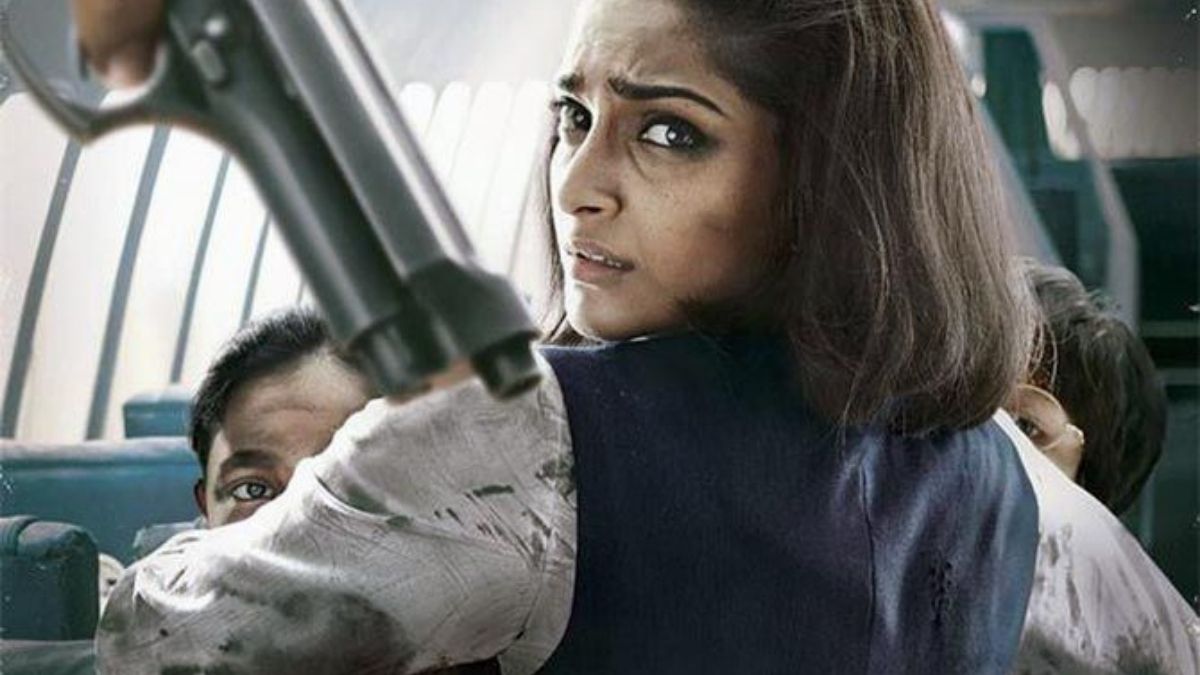
Bilkul ja…
Neerja
Director: Ram Madhvani
Actors: Sonam Kapoor, Shabana Azmi
Rating: ***
What’s there to even recreate, rewrite a real life event in order to film a story that you could learn absolutely everything about, from its rather simple beginning, middle and end, getting on Wikipedia in a minute, or checking out an effective enough docu or news feature on it? Is there good enough reason to undergo this pain? Plenty if you ask me. Though one can’t blame you for thinking otherwise.
Film is popularly perceived to be a story-telling medium. Which is only partly true. It is at its finest the best empathy generating machine we know. Therein lies the challenge for most filmmakers.
There’s a moment in this picture (and without quite the lead-up—in the promo too), when the father whose daughter’s flight has just been hijacked calls up the mom to merely tell her so. My eyes welled up instantly that second. That’s when it became easy to tell that the filmmakers here are very much up to the actual challenge. And for the most part, they’ve met it quite well too.
This isn’t to suggest that the story of young Neerja Bhanot, chief flight attendant or head purser in a plane that had been taken over by four terrorists from Abu Nidal, a jihadi outfit, in Karachi airport, is known to everyone anyway. The year is 1986, when transnational terrorism in the name of Islam was only beginning to raise its ugly head (it’s pretty much sitting on our heads now). It’s also the year when more than half of India currently was not even born.
Sonam Kapoor herself, the lead actor, admittedly had never heard of Neerja before doing this film. That of course is not a surprise. She’d recently referred to the Siachen soldier Lance Nayak Hanumanthappa Koppad on an Internet viral video as Lance, assuming Lance to be his first name!
Here’s the thing about certain actors though. They may appear to be wholly unaware of the world around them. But that handicap rarely shows up when they attempt to transpose that world on to the screen. Which is great.
Sonam plays an airhostess from a time when young Indian beautiful women saw that profession as fine ticket to high life and enviable glamour. The airhostesses on Air India (even the domestic Indian Airlines) back in the day, I’m told, were often called “hawai sundaris” (beauties in the sky—the likes of Maureen Wadia or Parmeshwar Godrej). This is of course generations before the adorable ‘ammas in air’ that we got blessed to fly with on our national carrier.
Neerja worked for the American airline, Pan Am. On the said September day when terrorists hijacked her plane, she had greatness thrust upon her. She could have broken down under pressure. She did the right thing—helping save 359 lives eventually.
The film seems obviously centred on Sonam. It’s hard to tell if any other actor would’ve cracked this role better. Suffice it to say the fears, mainly drawn from her painfully unendurable recent performances (Khubsoorat etc.), remain unfounded.
Shabana Azmi plays the 23-year-old girl’s mother, holding up like a rock. There is tension in the air. You almost hope things will be okay, even as you know they won’t (think A Mighty Heart, I guess).
But beyond the main leads, this picture is as much about voyeuristically recreating an experience inside a stuffy plane when an untoward incident of this sort occurs (like, I don’t know, United 931, perhaps?).
All the 379 passengers, besides the crew and the pilots, are involved in a hostage situation. All of them are actors in that sense. It’s hard to imagine how people would collectively react to a hijack. Thankfully there isn’t much hyperbole.
Especially among the smartly handpicked four hijackers. They don’t behave like Bollywood jihadi villains, only jihadi terrorists, or soldiers. One of them loses his mind, only reiterating how terrorism is a mental problem first, more than anything else.
The camera closely captures the insides of the flight apparatus, getting into the cock-pit, moving up the steps, moving down the aisle, giving you strong sense of the claustrophobic space.
Director Ram Madhvani, at the onset, is absolutely the perfect choice for an experiential film like this. Back in 2002, I remember being totally hit by his debut, Let’s Talk—set in one room over a couple of hours with only two actors on the screen. Stepping out of the film, I thought, “Wow a star is born!” That was Boman Irani’s debut. He’s very much a star in his roles now. The picture evidently did little for ad-filmmaker Madhvani’s career. This is only his second feature since.
What was fabulous about Let’s Talk (India’s most under-rated experimental film) is how it captured relationship between husband and wife from every conceivable angle. This makes the portions in this film where Neerja deals with the husband from her past appear strangely simplistic and sloppy. The bits about the family in the movie, and even a song in the middle of a hostage situation, seem far too much of a stretch.
But then, every time you feel maybe the filmmakers have dropped the ball, they manage to somehow re-establish radio-connect with the audience. And yeah, you do know the story. But your eyes well up still (okay mine did, again!)—this time watching Neerja go.
Mayank Shekhar’s book NAME PLACE ANIMAL THING, non-fiction on desis and pop-culture, is available online and at leading bookstores
